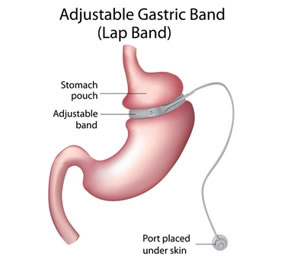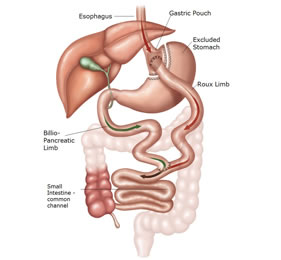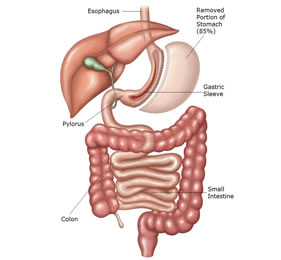 It is a purely restrictive procedure, and also a reversible one.
It is a purely restrictive procedure, and also a reversible one.
A Silastic Inflatable Band is placed at the upper end of stomach which constricts it to make a pouch of 25-30 ml. This is done with the help of four or five small (0.5-1.5cm) incisions. The inflation port (access port) is placed beneath the skin just above and to the left of umbilicus. This port is used to inflate or deflate the band with in turn regulates the size of stomach pouch. No abdominal drains are placed. The patient is usually discharged the next day.
The unique feature of this obesity procedure is its adjustability to control the weight, and that it can be reversed/ removed. Problems like band slippage, erosions and those related to access ports occur in less than 5% of patients.
Weight loss of the order of 0.5 to 1Kg in the first few weeks is expected, reaching an excess weight loss of 50-60% by two years, which is maintained thereafter.
 This is the current gold standard obesity surgical procedure. Since its inception in 1970s, it has stood the test of time and is a standard for comparison of other procedures.
This is the current gold standard obesity surgical procedure. Since its inception in 1970s, it has stood the test of time and is a standard for comparison of other procedures.
It is the most effective procedure for resolution of diabetes, sleep apnoea and control of hypertension. Currently it is being studied as a purely metabolic procedure for curing diabetes even in non-morbidly-obese.
In this, a small gastric pouch of 15-20ml is created, which leads to a reduction of food intake at a time. The intestinal architecture is then changed so that a large portion (175-250cm) of small intestine is bypassed, before the digestion and absorption of food starts. This results in malabsorption of food, and subsequent drastic weight loss. In the end, the integrity of pouch is checked using per-operative gastroscopy. A small abdominal drain is usually left which is taken out after 48-96 hours.
After the surgery, the patient is kept overnight under close observation. Next day, the patient is started with a clear liquid diet after doing a contrast X ray study, and shifted to room. He/she is encouraged to walk and do all routine activities.
He/she is discharged on the third or fourth day of surgery depending on the comfort of the patient and amount of oral intake. A detailed and properly explained discharge summary is given to the patient along with a diet chart.
First follow-up visit is after seven days. The clips/stitches are removed. By this time the expected weight loss is around 4-8 Kgs. The patient needs to take some vitamin and mineral supplements as presribed. Further follow-up protocol is given and the patient is encouraged to participate in support group meeting, routinely organized by the Institute.
 In this restricive procedure, the capacity of stomach is reduced to approximately 100ml, so the patient feels full early during a meal. It also shifts the hormonal balance so he/she feels less hungry between meals.
In this restricive procedure, the capacity of stomach is reduced to approximately 100ml, so the patient feels full early during a meal. It also shifts the hormonal balance so he/she feels less hungry between meals.
The dissection is started with disconnecting the greater omentum from the greater curvature of stomach. A 38F gastric calibration tube is inserted per oral. A stomach sleeve is created over this tube using multiple fires of linear staplers, preserving the gastric antrum. The integrity of the pouch is checked using per-operative gastroscopy. The excised portion of stomach is removed in a plastic bag. A small abdominal drain is usually left which is taken out after 48-72 hours.
After the surgery, the patient is kept overnight under close observation. Next day, the patient is started on a clear liquid diet after doing a contrast X-ray study, and shifted to room. He/she is encouraged to walk and do all routine activities.
He/she is discharged on the third or fourth day of surgery depending on the comfort of the patient and amount of oral intake. A detailed and properly explained discharge summary is given to the patient along with a diet chart.
First follow-up visit is after seven days. The clips/stitches are removed. By this time the expected weight loss is around 4-6 Kgs. Further follow-up protocol is given and few needed medicines are prescribed. With this procedure, a long term medicine or dietary supplementation is usually not required.
